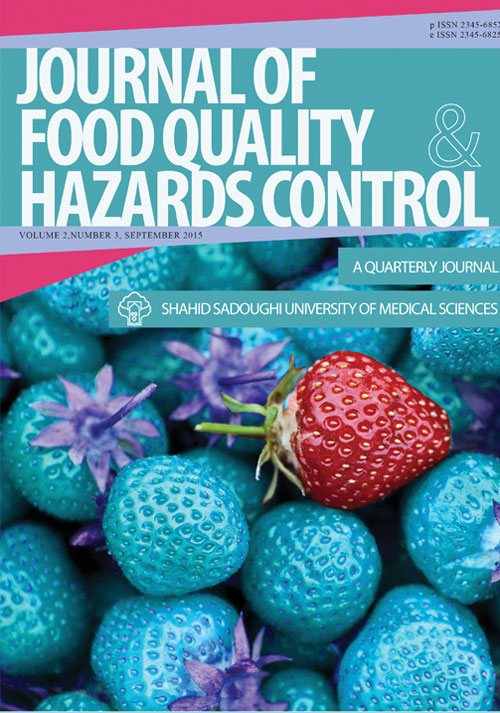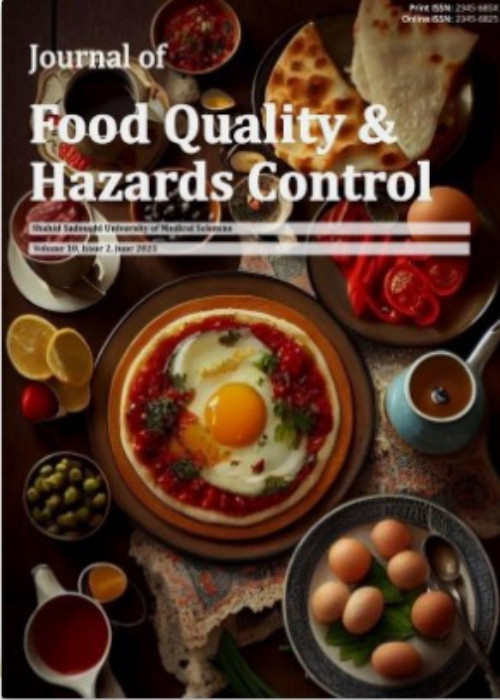فهرست مطالب

Journal of Food Quality and Hazards Control
Volume:2 Issue: 3, Sep 2015
- تاریخ انتشار: 1394/06/24
- تعداد عناوین: 8
-
-
Pages 81-85Celiac disease is the inability of the small intestine to tolerate some cereal prolamin with sequence specific oligopeptide. Wheat gliadin, rye secalins and barley hordenine are the main proteins involved in the disease mechanisms and may provoke an inflammatory process to damage the small intestine. There are different methods to overcome the problems for such patients; one of them is using gluten-free diet. Bread has the main role in the human diet and gluten is its main structure forming component. Gluten-free breads are produced by either cereals like wheat, barley and rye with removed prolamin or no prolamin containing ingredients. Considering the fact that gluten is the main protein in the formation of dough viscoelastic network, which is necessary to create the high quality bread, the aim of this review article is studying different factors with ability to improve quality of gluten-free bread produced for consumption of the vulnerable persons.Keywords: Diet, Gluten, Free, Bread, Food Quality, Celiac Disease
-
Pages 86-89BackgroundPseudomonas spp. are of important food spoiling bacteria. They present around the world and are isolated from diverse sources. The main objective of this survey was to detect Pseudomonas spp. in fresh chicken and fish obtained from markets of Assiut city, Egypt.MethodsIn this cross-sectional survey, 50 samples of fresh raw chicken and 50 samples of fresh raw fish meat were randomly collected from Assiut city markets, Egypt. Then, in laboratory, cultural and PCR techniques were carried out to detect Pseudomonas spp. in the samples.ResultsPseudomonas spp. were isolated from 80% of the examined chicken samples and found in all the examined fish samples. All the isolates were confirmed as Pseudomonas spp. using 16S rRNA-PCR. The average number of Pseudomonas spp. in chicken flesh and Tilapia nilotica were 2.6×104 and 2.8×103 CFU/g, respectively; while this rate was 1.4×105 CFU/g for African catfish (Clarias gariepinus).ConclusionsThis study indicated contamination of fresh raw fish and chicken samples with Pseudomonas spp. which may be attributed to cross contamination. This contamination predicts inadequate shelf life of the examined samples especially African catfish.Keywords: Chickens, Fish Products, Pseudomonas, Food Quality
-
Pages 90-96BackgroundPhysical characteristics of crops play an important role in designing the required machinery and apparatus for planting, harvesting, transport, processing and also storing. The aim of this study was to determine physical characteristics of some native rice varieties cultivated in northern Iran, namely Gerde, Shafagh, Tarom-e-Hashemi, Shiroodi and Keshvari.MethodsSome geometrical, gravimetrical and frictional characteristics of the five varieties were determined by standard methods at their initial wet basis moisture content ranging between 10-11% (w.b.). Data analysis was carried out by SPSS software (ver. 16.0) using one-way ANOVA.ResultsAmong all the five studied rice varieties, the highest length, width and thickness values were measured as 8.06 mm, 3.59 mm and 2.87 mm, belonging to Shafagh, Gerde and Shiroodi varieties, respectively which each of them had significance difference (p<0.05) with the other varieties from point of view of the mentioned characteristics. Also, Shafagh and Keshvari revealed maximum and minimum values of volume, equivalent diameter and surface area, respectively. Shafagh had also the highest rate of weight of thousand grains (25.06 g). Gerde was found to be the most spherical variety and revealed the highest bulk density (0.82 kg/m3) and angle of repose (45.57º) while having minimum true density (1.41 kg/m3).ConclusionsThere were significant differences among the examined varieties in the case of physical properties and most of these properties were related to each other. These data could be useful for resolving some problems associated with design, development and analysis of behavior of products during post-harvest processing.Keywords: Oryza sativa, Food Quality, Analysis
-
Pages 97-100BackgroundToxoplasmosis is one of the most important food-borne diseases distributed worldwide. In order to determinate the involvement of poultry meat in clinical toxoplasmosis, this study aimed to genetic characterization of Toxoplasma gondii in tissue samples of serologically positive chickens of Tunisia using Polymerase Chain Reaction (PCR).MethodsTrail of isolation of local T. gondii chicken strains through bioassay of the suspected infected chicken tissues in mice was carried out and the isolated strains were typed using PCR-RFLP targeting the marker AK69. Data analysis was performed by SPSS 16.0.ResultsOut of 40 seropositive chickens, 15 were positive by AK69 gene PCR. RFLP analysis showed high prevalence of type II T. gondii in infected poultry meats in Tunisia.ConclusionIt seems that chicken meat of this region is not a risk factor of congenital toxoplasmosis. However, direct genotyping approach and deeper analysis should be investigated to have clearer idea about the epidemiology of the parasite and its transmission routs in Tunisia.Keywords: Toxoplasma, Meat, Chickens, Polymerase Chain Reaction
-
Pages 101-106BackgroundListeria monocytogenes is one of the most important food-borne bacteria causing septicemia, meningitis and encephalitis in humans. The objective of this study was to evaluate the occurrence and antibiotic resistance of the bacterium in retail minced beef in Ahvaz, South-West of Iran.MethodsIn this survey, 150 samples of minced beef were randomly obtained from retail butcheries in Ahvaz, Iran and tested for presence of L. monocytogenes. The procedure was one-step enrichment in Listeria enrichment broth followed by plating on oxford agar. Isolated colonies were subjected to subsequent biochemical tests and polymerase chain reaction (PCR) assay using the target iap-P60 gene encoding P60 protein. Susceptibility of the isolates to various antibiotics was investigated by Kirby-Bauer disk diffusion method. The results were analyzed by chi-square test and fisher’s exact test using SPSS 16.0 software.ResultsThe incidence of Listeria spp. was 2.7% (4 of 150 samples) and only one sample (0.66%) was contaminated to L. monocytogenes. Statistical analysis showed no significant difference in prevalence of Listeria between various regions (p>0.05). The isolate was resistant to streptomycin and showed an intermediate susceptibility to tetracycline and penicillin. However, it was sensitive to other tested antibiotics.ConclusionOur findings showed the presence of antibiotic resistant L. monocytogenes strain among beef samples in this region of Iran and so, indicated the potential risk for public health from consumption of raw or undercooked beef which may increase the possibility of acquisition of resistance to antibiotics.Keywords: Listeria monocytogenes, Meat, Polymerase Chain Reaction, Drug Resistance, Microbial
-
Pages 107-110BackgroundDate (Phoenix dactylifera L.) is one of the most important agricultural crops in Iran. This study was carried out to determine the possibility of using date paste for manufacturing a new ready-to-eat food product.MethodsVarious formulations were prepared by mixing Mazafati date paste, bread, oil (animal and olive), nuts and spices; but only six formulas were chosen according to sensory evaluation. The six formulations consisted of different ratios of the date paste (40, 50, and 60%), Sangak bread (25, 35, and 45%), nuts (9%), spices (1%) and animal or olive oil (5%). The research was conducted in a completely randomized design test with three replications. Statistical analysis of the data was carried out using SAS software (ver. 9.1).ResultsThe formulas contained various ranges of fat (13.20-15.86%), reducing sugars (25.16-32.50%), sucrose (2.90-6.63%) and protein (5.85-7.80%). The pH value of the formulas ranged from 5.65 to 5.79. The formulations containing 60% date paste had significantly higher amounts of moisture, sucrose and reducing sugars (p<0.05). Although there were no significant difference in the sensorial attributes (taste, texture, odour) between the formulas 3 and 6 (60% date paste, 25% bread and 5% animal or olive oil), they gained the highest score in comparison to other formulas.ConclusionAccording to the results, the formulas 3 and 6 possessed desirable quality and high nutritional value and therefore, are recommended to be used in the manufacture of the new ready-to-eat food product.Keywords: Phoeniceae, Food, Formulated, Sensation


